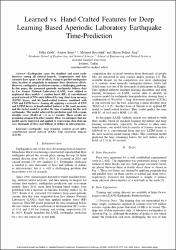| dc.contributor.author | Zaidi, Talha | |
| dc.contributor.author | Samy, Asmaa | |
| dc.contributor.author | Kocatürk, Mehmet | |
| dc.contributor.author | Ateş, Hasan Fehmi | |
| dc.date.accessioned | 2021-02-12T07:49:52Z | |
| dc.date.available | 2021-02-12T07:49:52Z | |
| dc.date.issued | 2020 | en_US |
| dc.identifier.citation | Zaidi, T., Samy, A., Kocatürk, M. ve Ateş, H. F. (2020). Learned vs. hand-crafted features for deep learning based aperiodic laboratory earthquake time-prediction. 28th Signal Processing and Communications Applications Conference (SIU). Gaziantep, Turkey, 5-7 October 2020. https://dx.doi.org/10.1109/SIU49456.2020.9302474 | en_US |
| dc.identifier.isbn | 9781728172064 | |
| dc.identifier.issn | 2165-0608 | |
| dc.identifier.uri | https://dx.doi.org/10.1109/SIU49456.2020.9302474 | |
| dc.identifier.uri | https://hdl.handle.net/20.500.12511/6558 | |
| dc.description.abstract | Earthquakes cause the deadliest and most costly disasters among all natural hazards. Geophysicists and data scientists have spent a lot of effort, trying to predict earthquakes time, location or magnitude to minimize these disastrous effects. However, earthquakes prediction remains a challenging problem. In this paper, the generated aperiodic earthquake failures data by Los Alamos National Laboratory (LANL) were utilized to implement three models: i) random forest (RF), ii) convolutional neural network (CNN) units followed by long short-term memory (LSTM) layers, and iii) hand-crafted features combined with CNN and LSTM layers. Among all, applying a network of CNN and LSTM layers to hand-crafted features is the most accurate and the fastest model to predict the time remaining for the next earthquake. This model achieved the prediction goal with a mean absolute error (MAE) of 1.51 in 44 seconds. These results are promising compared to other models. Thus, we anticipate that our model can be improved and applied to real seismic data that can save thousands of lives and billions of dollars in infrastructure. | en_US |
| dc.language.iso | eng | en_US |
| dc.publisher | Institute of Electrical and Electronics Engineers Inc. | en_US |
| dc.rights | info:eu-repo/semantics/embargoedAccess | en_US |
| dc.subject | Earthquake | en_US |
| dc.subject | Deep Learning | en_US |
| dc.subject | Random Forest (RF) | en_US |
| dc.subject | Convolutional Neural Network (CNN) | en_US |
| dc.subject | Long Short-Term Memory (LSTM) | en_US |
| dc.title | Learned vs. hand-crafted features for deep learning based aperiodic laboratory earthquake time-prediction | en_US |
| dc.type | conferenceObject | en_US |
| dc.relation.ispartof | 28th Signal Processing and Communications Applications Conference (SIU) | en_US |
| dc.department | İstanbul Medipol Üniversitesi, Mühendislik ve Doğa Bilimleri Fakültesi, Elektrik ve Elektronik Mühendisliği Bölümü | en_US |
| dc.authorid | 0000-0003-1744-5252 | en_US |
| dc.authorid | 0000-0002-6842-1528 | en_US |
| dc.relation.publicationcategory | Konferans Öğesi - Uluslararası - Kurum Öğretim Elemanı | en_US |
| dc.identifier.doi | 10.1109/SIU49456.2020.9302474 | en_US |


















